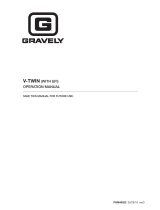
·1
To
The
Owner
Thank
You
This
Operator's
ManuaHs
an
important part
of
your
new
engine.
It will help
you
prepare
and
maintain the engine for the
best
performance"PI,ejise
read
and
understand the contents before operating the
engine.
table
of
Contents
1
Safe
Operation
Practices
........................................
3 Troubleshooting
...........................................
..........
7S
Safety
Symbols
........................................................
4
Replacement
Parts
.................................................
76
Set-Up
................................................
.
~
.....................
5-
Emission
Statement/WarrolJty
.................................
.
Contr,ols
&
Features
...............................................
:.
7 .....................................
See
Seperate
Supplement,
Operation
.............................................
....................
8
Spanish
...............................................
.....................
19
Maintenance
•••••••••••••••••.•••••••••••••••••••.••••.
................
'77
Record
Product
Information
Before
operating your
new
engine,
please
locate the model plate
on
the engine
and
record
the information in the provided
area
MODEL
NUMBER/SERIAL NUMBER
to the right.
This
information will
be
necessary,
should
you
seek
technical support
via
our
web
site
or with your
local
dealer.
DDDDDDD/DDDDDDDDDDDD
Customer
Support
Please
do
NOT
return the machine to
the
retaJler
or dealer without first contacting our
Customer
Support Department.
If
you
have
difficulty with
this
product or
have
any
questions
regarding
the controls, operation, or
maintenance
of this
engine,
you
can
seek
help froin the
experts.
Choose
from the options below:
()
Visit
us
on
the
web
at www.mtdproducts.com
()
Call
a
Customer
Support
Representative
at
(800)
800-7310
or
(330)
220-4683
()
Write
us
at
MTD
LLC·
P.O.
Box
361131
•
Cleveland,
OH
·44136-0019

















